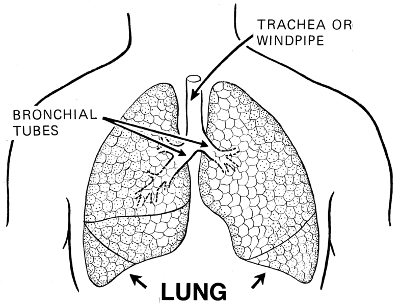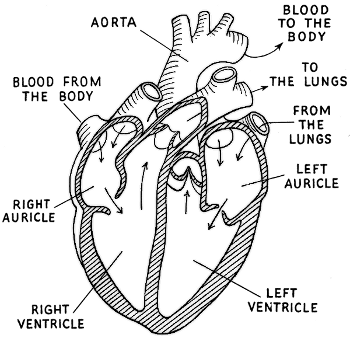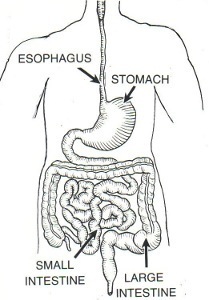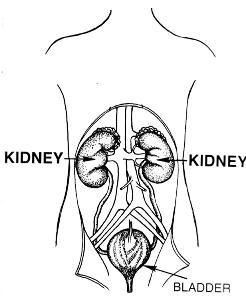
Published by K12 Handhelds, Inc.
Portal, AZ
www.k12handhelds.com
Copyright © 2006 by K12 Handhelds, Inc. License CC-by, 
This work is licensed under a Creative Commons Attribution 3.0 United States License.
Table of Contents
- Introduction
- Respiratory System
- Circulatory System
- Digestive System
- Excretory System
- Nervous System
- Other Systems
- Glossary
- Credits
Introduction
The human body has an amazing number of parts that work together to keep us alive and healthy. The body consists of many systems. Each system has a special role, such as to provide blood or to get nutrition from food. Each system is made up of different organs that have special jobs.
Respiratory System
The job of the respiratory system is to take oxygen from the air we breathe and get it to different parts of the body. Our bodies and the cells in them need oxygen (written with the chemical symbol O2) to live. Our cells give off carbon dioxide (written with the chemical symbol CO2) as a waste product or something they don’t need any more. The respiratory system takes this carbon dioxide out of the body.
The main organ of the respiratory system is the lungs. The respiratory system starts when you take a breath. There is a muscle called the diaphragm that is at the bottom of the rib cage. It helps draw air into the lungs.
Once a breath is taken, the air travels through the mouth or nose and travels through the windpipe into the lungs. Once the air is down the windpipe, it splits one of two directions into tubes called bronchi and then into the lungs. The bronchi branch off into more and more smaller tubes. At the very end of these are small sacs called alveoli.
In the alveoli, the respiratory system works with the circulatory system. Small blood vessels take oxygen from the alveoli to the heart for distribution to the rest of the body. Blood also brings carbon dioxide to be exhaled back out.
When we breathe in or inhale, the air coming into the body has a lot of oxygen. When we breathe out or exhale, the air has more carbon dioxide.

Questions
1. What is the main job of the respiratory system?
A) to take wastes out of the body
B) to turn food into nutrients
C) to deliver oxygen and nutrients to cells in the body
D) to bring oxygen into the body
2. What gas do our cells need?
A) carbon dioxide
B) nitrogen
C) oxygen
3. What gas do our cells give off as waste?
A) nitrogen
B) carbon dioxide
C) oxygen
Circulatory System
The circulatory system includes the heart, blood, and a huge network of blood vessels that carry blood all over the body. The job of the circulatory system is to deliver oxygen to cells all over the body and then to carry out waste product like carbon dioxide.
The heart is an organ made out of muscle. It’s job is to pump blood through the body. The heart has four main sections or chambers:
- Right atrium
- Right ventricle
- Left atrium
- Left ventricle
Blood flows into the right atrium through two large blood vessels called the superior vena cava (from the upper body) and the inferior vena cava (from the lower body). From there blood moves to the right ventricle. It then travels to the lungs to get oxygen.
Blood coming back from the lungs enters the left atrium and then into the left ventricle. From there it leaves the heart through the aortic valve and goes into the aorta. This is the largest artery in the body, and it leads to all parts of the body.

There are many kinds blood vessels that carry blood around the body. Arteries carry blood away from the heart. (You can remember arteries and away.) Veins carry blood back to the heart.
Blood that is coming from the lungs has lots of fresh oxygen in it and is bright red. After the oxygen is delivered to cells and carbon dioxide is picked up, the blood is darker colored.
Blood is made up of a liquid called plasma and three kinds of cells. Red blood cells carry oxygen to the various parts of the body. White blood cells help fight disease. Platelets help blood clot.
Questions
4. What is the main job of the circulatory system?
A) to bring oxygen into the body
B) to deliver oxygen and nutrients to cells in the body
C) to take wastes out of the body
D) to turn food into nutrients
5. Which blood vessels carry blood back to the heart?
A) aveoli
B) aortas
C) arteries
D) veins
6. What is the liquid part of blood called?
A) plasma
B) red blood cells
C) platelets
D) white blood cells
Digestive System
Our bodies need food to live and grow. The digestive system takes food and carries it to all the parts of the body.
The beginning of the digestive system is the mouth and teeth. Food that we eat has to be broken down into nutrients that cells in our bodies can use. This starts with the teeth and tongue grinding food into smaller pieces. Saliva also helps break down food.
Then the food is swallowed and goes down the esophagus, a tube that goes from the mouth to the stomach. The stomach breaks down the food further. Gastric juices that have acids and enzymes in them that help the process.
Then the food goes to the small intestine. This is a long twisting tube that fills up much of your lower abdomen area. It is where most of the digestion occurs. The liver produces bile, and the pancreas produces juices that help break food down. Small blood vessels line the walls of the small intestine. Once the food is broken down, the nutrients are absorbed by these blood vessels. The blood then carries the nutrients to cells all over the body.
The part of the food that is left moves on to the large intestine.

Questions
7. What is the main job of the digestive system?
A) to bring oxygen into the body
B) to take wastes out of the body
C) to turn food into nutrients
D) to deliver oxygen and nutrients to cells in the body
8. What is the tube that goes from the mouth to the stomach called?
A) esophagus
B) windpipe
C) small intestine
D) brochi
9. What is the first part of the digestive system?
A) stomach
B) mouth
C) esophagus
D) large intestine
10. What is the last part of the digestive system?
A) small intestine
B) esophagus
C) large intestine
D) stomach
Excretory System
After food goes through the digestive system, the parts that are not digested need to be gotten rid of. That is the job of the excretory system.
Unabsorbed food goes to the large intestine. The liver also filters out solid particles of waste from the blood. These solid wastes are removed from the body through the rectum, which is at the end of the large intestine.
Liquid wastes are filtered by the kidneys, a part of the excretory system. The kidneys have long tubes coming out of them called ureters that drain liquid into the bladder. The bladder stores liquid waste called urine until it is passed out of the body through the urethra.

Questions
11. What is the main job of the excretory system?
A) to bring oxygen into the body
B) to take wastes out of the body
C) to deliver oxygen and nutrients to cells in the body
D) to turn food into nutrients
12. Which organ filters liquid wastes?
A) liver
B) small intestine
C) ureters
D) kidneys
13. What tube carries urine out of the body?
A) ureters
B) urethra
C) kidneys
D) bladder
Nervous System
The nervous system includes the brain, the spinal cord, and neurons that go through your whole body. The nervous system controls all the other functions of the body. It controls breathing, the beating of the heart, and the functions of all the other organs.
Like the other body systems, we couldn’t live without it.
Other Systems
There are other systems in the body besides these. The musculoskeletal system includes all of our bones and muscles. Our skin is the organ that covers the outside of our body. The immune system fights off disease and infections. The endocrine system is a system of glands that make chemicals our bodies need to function. The reproductive system is responsible for new human life.
All of these systems work together to make us the amazing beings we are!
Glossary
abdomen – the belly; the part of the body below the chest
alveoli – a small sac in the lung where oxygen and carbon dioxide are exchanged through blood
aorta – the largest artery in the body; goes from the heart to arteries that go to the rest of the body
arteries – blood vessels that carry blood away from the heart
blood vessels – tubes that carry blood; examples include arteries and veins
bronchi – two tubes that go from the windpipe to the left and right lungs
clot – to stick together; blood that clots helps stop bleeding
diaphragm – a muscle between the chest and abdomen that helps draw air in and out of the lungs
enzyme – a protein that causes certain reactions
esophagus – the tube that food and drink goes through to get from the mouth to the stomach
exhale – to breathe out
gastric – juices acidic liquids produced by the lining of the stomach that aid in digestion
inhale – to breathe in
lung – an organ in the body that takes oxygen out of the air breathed; part of the respiratory system
nutrient – something that gives the body energy
organ – a part of the body made up of cells that work together do some job; examples include the heart and the brain
plasma – the liquid part of blood
platelets – cells in blood that help blood clot
rectum – the end of the large intestine
saliva – spit; liquid in the mouth that has enzymes that help break down food
system – a group of parts that work together to do some job
veins – blood vessels that carry blood to the heart
windpipe – the main tube that air goes through to get from the nose and mouth to the lungs
Credits
1, 3, 4 – Pearson Scott Foresman public domain
2 – WPClipart public domain